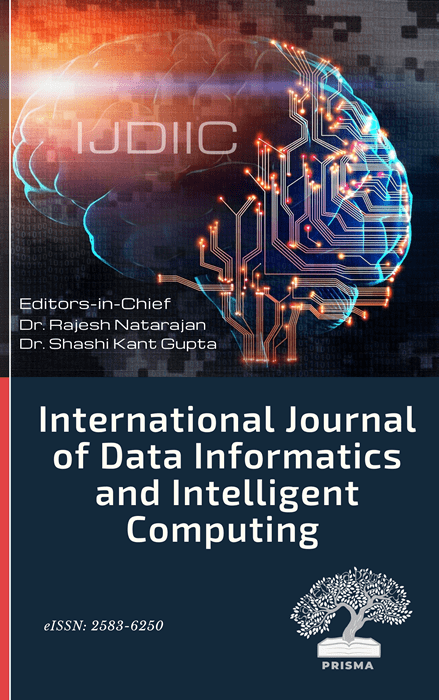Ant with Artificial Bee Colony Techniques in Vehicular Ad-hoc Networks
DOI:
https://doi.org/10.59461/ijdiic.v2i3.69Keywords:
Artificial Bee Colony , Ant Colony, Vehicular ad-hoc networks, Quality of ServicesAbstract
A VANET faces many problems due to dynamic changing of networks with certain requirements such as low delay, high (PDR) packet delivery ratio, low routing overhead and throughput. However, numerous routing protocols have been suggested to meet the demands of Quality of Service (QoS), but none of them can consistently maintain the highest level of QoS simultaneously. The proposed method Ant with Artificial Bee Colony Techniques provides better performance when compared to the existing techniques. This work is compared with latest developed Techniques in VANET to find the best path and different performance metrics are used to check the performance. This work premeditated the comparative analysis of Quality of services made by the performance of latest emerging techniques in VANET and will provide the best solution for the recognition problem in finding the best path based on the evaluation of performance of Quality of Service. Simulation results imply the benefits of the proposed Ant with Artificial Bee Colony Techniques (AABC) produces better result when compare to the other conventional method and Ant Colony Techniques(ACT)in terms of high packet delivery ratio, less end-to-end delay and less energy consumption level. The performance is evaluated by using Ns2 simulator and results shows that the AABC successfully achieve the optimal routes.
Downloads
References
X. Zhang and X. Zhang, “A binary artificial bee colony algorithm for constructing spanning trees in vehicular ad hoc networks,” Ad Hoc Networks, vol. 58, pp. 198–204, Apr. 2017, doi: 10.1016/j.adhoc.2016.07.001.
H. Hakli and M. S. Kiran, “An improved artificial bee colony algorithm for balancing local and global search behaviors in continuous optimization,” Int. J. Mach. Learn. Cybern., vol. 11, no. 9, pp. 2051–2076, Sep. 2020, doi: 10.1007/s13042-020-01094-7.
N. Karaboga, “A new design method based on artificial bee colony algorithm for digital IIR filters,” J. Franklin Inst., vol. 346, no. 4, pp. 328–348, May 2009, doi: 10.1016/j.jfranklin.2008.11.003.
A. K. Shukla and V. Suresh Kumar, “Cloud Computing with Artificial Intelligence Techniques for Effective Disease Detection,” Int. J. Data Informatics Intell. Comput., vol. 2, no. 1, pp. 32–41, Mar. 2023, doi: 10.59461/ijdiic.v2i1.45.
S. S. C. Bose, B. S. Alfurhood, G. H. L, F. Flammini, R. Natarajan, and S. S. Jaya, “Decision Fault Tree Learning and Differential Lyapunov Optimal Control for Path Tracking,” Entropy, vol. 25, no. 3, p. 443, Mar. 2023, doi: 10.3390/e25030443.
Manju Bargavi, M.Senbagavalli, Tejashwini.K.R, and Tejashvar.K.R, “Data Breach – Its Effects on Industry,” Int. J. Data Informatics Intell. Comput., vol. 1, no. 2, pp. 51–57, Dec. 2022, doi: 10.59461/ijdiic.v1i2.31.
D. Karaboga and B. Basturk, “Artificial Bee Colony (ABC) Optimization Algorithm for Solving Constrained Optimization Problems,” in Foundations of Fuzzy Logic and Soft Computing, Berlin, Heidelberg: Springer Berlin Heidelberg, pp. 789–798. doi: 10.1007/978-3-540-72950-1_77.
C. Chidambaram and H. S. Lopes, “A new approach for template matching in digital images using an Artificial Bee Colony Algorithm,” in 2009 World Congress on Nature & Biologically Inspired Computing (NaBIC), IEEE, Dec. 2009, pp. 146–151. doi: 10.1109/NABIC.2009.5393631.
T. R. Benala, S. H. Villa, S. D. Jampala, and B. Konathala, “A novel approach to image edge enhancement using Artificial Bee Colony optimization algorithm for hybridized smoothening filters,” in 2009 World Congress on Nature & Biologically Inspired Computing (NaBIC), IEEE, 2009, pp. 1071–1076. doi: 10.1109/NABIC.2009.5393866.
H.-B. DUAN, C.-F. XU, and Z.-H. XING, “A HYBRID ARTIFICIAL BEE COLONY OPTIMIZATION AND QUANTUM EVOLUTIONARY ALGORITHM FOR CONTINUOUS OPTIMIZATION PROBLEMS,” Int. J. Neural Syst., vol. 20, no. 01, pp. 39–50, Feb. 2010, doi: 10.1142/S012906571000222X.
E. Kaya, B. Gorkemli, B. Akay, and D. Karaboga, “A review on the studies employing artificial bee colony algorithm to solve combinatorial optimization problems,” Eng. Appl. Artif. Intell., vol. 115, p. 105311, Oct. 2022, doi: 10.1016/j.engappai.2022.105311.
R. Qun and S. M. Arefzadeh, “A new energy‐aware method for load balance managing in the fog‐based vehicular ad hoc networks (VANET) using a hybrid optimization algorithm,” IET Commun., vol. 15, no. 13, pp. 1665–1676, Aug. 2021, doi: 10.1049/cmu2.12179.
C. Nandagopal, P. Siva Kumar, R. Rajalakshmi, and S. Anandamurugan, “Mobility Aware Zone-Based Routing in Vehicle Ad hoc Networks Using Hybrid Metaheuristic Algorithm,” Intell. Autom. Soft Comput., vol. 36, no. 1, pp. 113–126, 2023, doi: 10.32604/iasc.2023.031103.
R. Natarajan, S. R. P, S. C. Bose, H. L. Gururaj, F. Flammini, and S. Velmurugan, “Fault detection and state estimation in robotic automatic control using machine learning,” Array, vol. 19, p. 100298, Sep. 2023, doi: 10.1016/j.array.2023.100298.
M. Arif, G. Wang, T. Peng, V. E. Balas, O. Geman, and J. Chen, “Optimization of communication in VANETs using fuzzy logic and artificial Bee colony,” J. Intell. Fuzzy Syst., vol. 38, no. 5, pp. 6145–6157, May 2020, doi: 10.3233/JIFS-179697.
Downloads
Published
How to Cite
Issue
Section
License
Copyright (c) 2023 C.Kumuthini, N.Thangarasu, K.Kavitha, K.Gomathy

This work is licensed under a Creative Commons Attribution-ShareAlike 4.0 International License.








